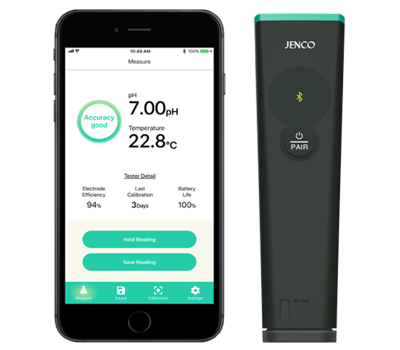
There are a variety of PH testers on the market, and each is designed with a different application in mind. To choose the best pH tester, it’s important to know what features to look for based on your intended use.
We’ve outlined a few common features of pH testers and explained why they’re relevant in different scenarios to help you narrow down your search.
Choosing the Right Model for Your Needs
The oldest and most basic method of pH testing involves using litmus paper. Litmus strips are sold in a pack or bundle and are designed to be used once and then thrown away. The strips change color based on the pH of the substance in which they’re submerged, indicating whether that substance is acidic or basic. Because the results are qualitative (observable) not quantitative (measurable), litmus paper isn’t capable of identifying how acidic or alkaline a substance is with good accuracy. Results are also more likely to vary between users because of the more subjective nature of comparing used strips to color charts.
Today, pH testers and meters have largely replaced traditional litmus paper tests as a more reliable, sustainable, efficient, and accurate alternative. Digital pH testers come in a variety of forms, sizes, and levels of sophistication. As you search for your ideal pH tester and compare different products, here are some key factors to keep in mind:
Temperature Compensation
Why, you might ask, would you need a temperature reading on your pH tester? The pH of a substance is directly influenced by temperature, so taking consistent and accurate pH readings requires knowing the temperature at which each reading is taken. As a general rule, when the temperature of a substance increases, its pH decreases.
Although it’s possible to measure temperature with a thermometer and use a separate tester to measure pH, more advanced pH testers provide both functions in one tool and help the user account for temperature variance with automatic temperature compensation (ATC) or solution temperature compensation (STC). ATC is an automated calculation and doesn’t require that pH readings be taken at the same temperature. In contrast, STC requires greater temperature consistency between readings and/or manually inputting temperature into the tester. If you’re looking to achieve more consistent and accurate pH readings without expending extra time or computing effort, look for a dual pH and temperature tester with ATC to automatically compensate for temperature and reduce the probability of human error.
Portability and Durability
If you plan to use your pH tester outside of a lab, then it’s important to choose a tester that’s portable, light, durable, and easy to grip. In addition, consider the environment that you’ll be working in and what wear and tear the tester might fall victim to. If you’re testing water quality in rugged settings, you may opt for a meter that’s robust enough to withstand small impacts and designed to be resilient to moisture, dust, and other natural elements. For any portable meter, it’s also important to consider readability (Is the screen backlit for easy viewing? Is it clear and easy to read? ), ease of use (Can it be operated with one hand? Is it easy to navigate the data?), and battery life.
If you’re not looking to travel with your pH meter or if you need to take frequent readings from the same location, a benchtop meter or in-line monitor may make more sense for your purposes. Like portable testers, benchtop meters and in-line monitors range from basic to incredibly sophisticated. As you compare models, consider what level of insight and functionality will help you achieve your goals.
Data Storage, Accessibility, and Shareability
One of the greatest benefits of digital pH meters is their ability to store and retrieve archived data. More advanced pH testers can save calibration information and will date and time-stamp readings for easy retrieval and analysis. If you’re looking to save and compare readings over an extended period or wish to collect a large number of data points without constantly clearing your device, look for a meter with robust memory storage. Along with internal memory, some meters offer bluetooth or cloud compatibility, making it exceptionally easy to store, browse, share, and analyze data from remote locations. Bluetooth compatible testers that pair with a smartphone app enable users to automatically view pH and calibration results, browse data, and customize settings from the field using a more comprehensive and familiar interface. Smartphone compatible devices can also provide added benefits such as GPS tracking and mapping to assign every data point a geographic location.
To browse and compare Jenco Instruments’ various products with pH testing capabilities, and shop for your ideal solution, click the button below.


Comments